Analysis of the Effects of Healthcare Reform on Key Stakeholders
VerifiedAdded on 2022/07/29
|7
|1658
|53
Essay
AI Summary
This essay analyzes the multifaceted effects of healthcare reform, primarily focusing on the Affordable Care Act (ACA), on key stakeholders within the healthcare system. It examines the financial impacts, benefits, and drawbacks experienced by insurance companies, pharmaceutical firms, healthcare providers (doctors and hospitals), patients, employers, and the government. The essay details how the ACA has influenced insurance rates, tax codes, and the provision of healthcare plans, as well as the effects on prescription spending and access to medical services. It highlights both the positive outcomes, such as increased insurance coverage and access to care, and the negative consequences, including potential financial strains on insurance companies and increased demands on healthcare providers. The essay concludes by suggesting the need for potential revisions to the ACA to mitigate its disadvantages and ensure equitable healthcare access for all Americans.
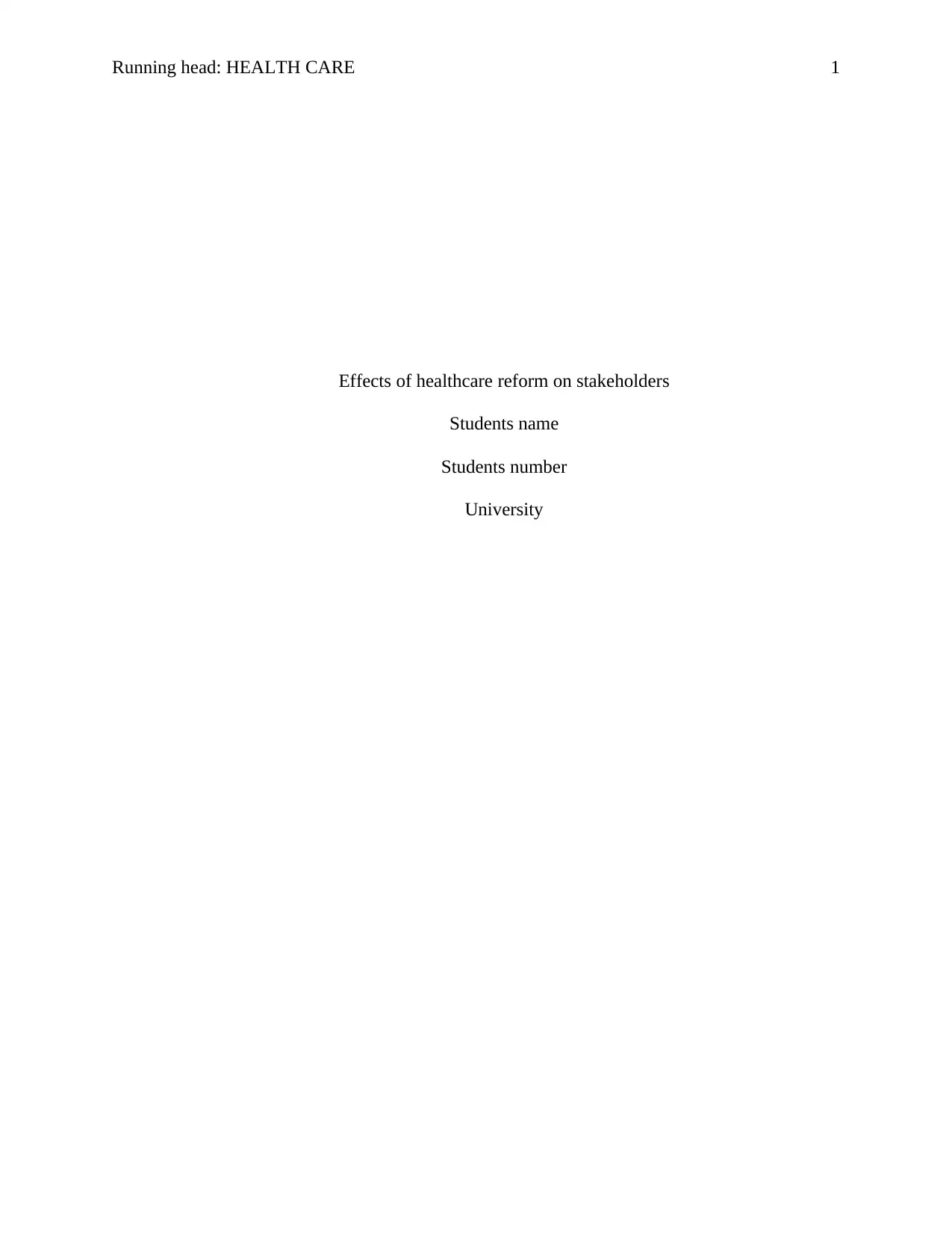
Running head: HEALTH CARE 1
Effects of healthcare reform on stakeholders
Students name
Students number
University
Effects of healthcare reform on stakeholders
Students name
Students number
University
Paraphrase This Document
Need a fresh take? Get an instant paraphrase of this document with our AI Paraphraser
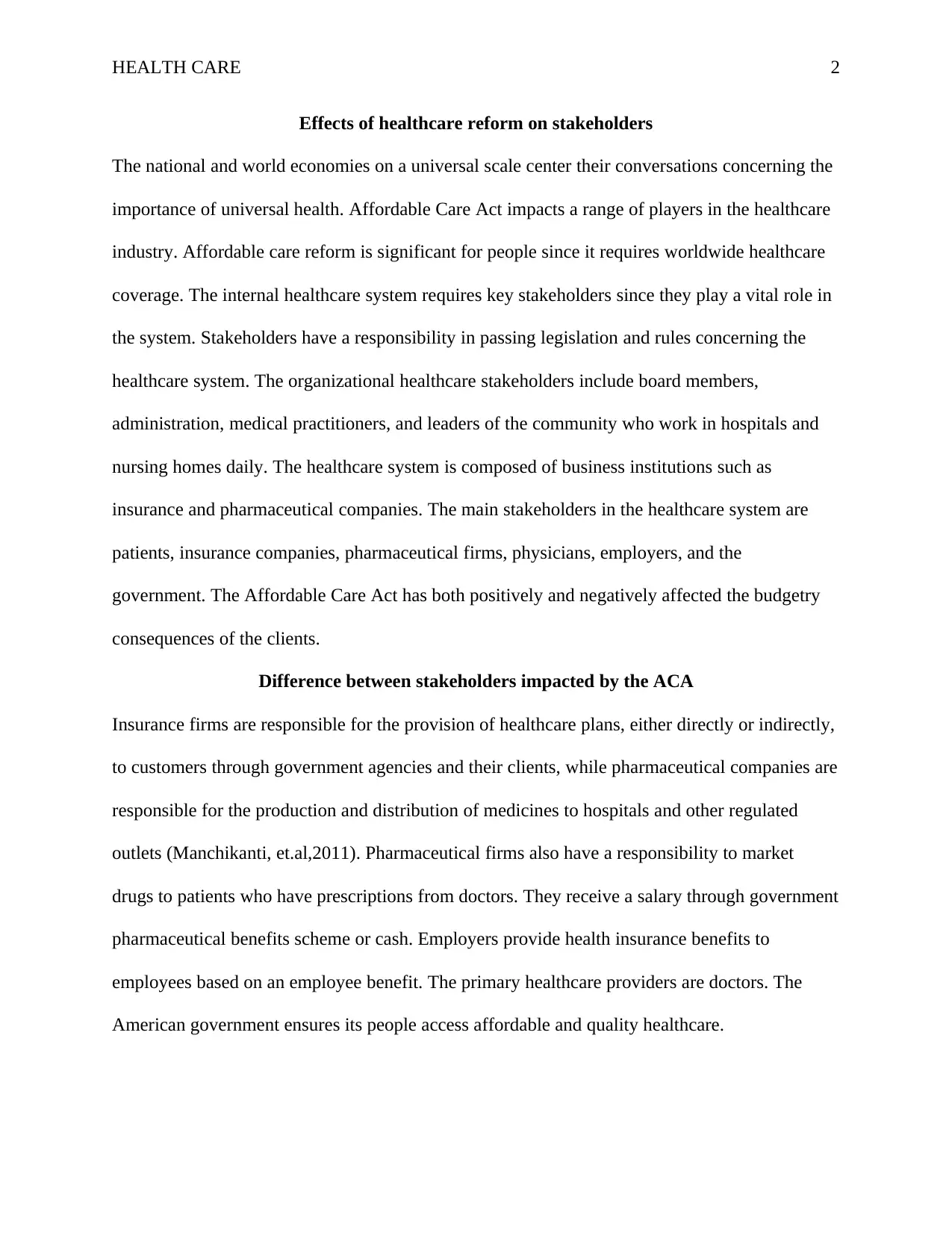
HEALTH CARE 2
Effects of healthcare reform on stakeholders
The national and world economies on a universal scale center their conversations concerning the
importance of universal health. Affordable Care Act impacts a range of players in the healthcare
industry. Affordable care reform is significant for people since it requires worldwide healthcare
coverage. The internal healthcare system requires key stakeholders since they play a vital role in
the system. Stakeholders have a responsibility in passing legislation and rules concerning the
healthcare system. The organizational healthcare stakeholders include board members,
administration, medical practitioners, and leaders of the community who work in hospitals and
nursing homes daily. The healthcare system is composed of business institutions such as
insurance and pharmaceutical companies. The main stakeholders in the healthcare system are
patients, insurance companies, pharmaceutical firms, physicians, employers, and the
government. The Affordable Care Act has both positively and negatively affected the budgetry
consequences of the clients.
Difference between stakeholders impacted by the ACA
Insurance firms are responsible for the provision of healthcare plans, either directly or indirectly,
to customers through government agencies and their clients, while pharmaceutical companies are
responsible for the production and distribution of medicines to hospitals and other regulated
outlets (Manchikanti, et.al,2011). Pharmaceutical firms also have a responsibility to market
drugs to patients who have prescriptions from doctors. They receive a salary through government
pharmaceutical benefits scheme or cash. Employers provide health insurance benefits to
employees based on an employee benefit. The primary healthcare providers are doctors. The
American government ensures its people access affordable and quality healthcare.
Effects of healthcare reform on stakeholders
The national and world economies on a universal scale center their conversations concerning the
importance of universal health. Affordable Care Act impacts a range of players in the healthcare
industry. Affordable care reform is significant for people since it requires worldwide healthcare
coverage. The internal healthcare system requires key stakeholders since they play a vital role in
the system. Stakeholders have a responsibility in passing legislation and rules concerning the
healthcare system. The organizational healthcare stakeholders include board members,
administration, medical practitioners, and leaders of the community who work in hospitals and
nursing homes daily. The healthcare system is composed of business institutions such as
insurance and pharmaceutical companies. The main stakeholders in the healthcare system are
patients, insurance companies, pharmaceutical firms, physicians, employers, and the
government. The Affordable Care Act has both positively and negatively affected the budgetry
consequences of the clients.
Difference between stakeholders impacted by the ACA
Insurance firms are responsible for the provision of healthcare plans, either directly or indirectly,
to customers through government agencies and their clients, while pharmaceutical companies are
responsible for the production and distribution of medicines to hospitals and other regulated
outlets (Manchikanti, et.al,2011). Pharmaceutical firms also have a responsibility to market
drugs to patients who have prescriptions from doctors. They receive a salary through government
pharmaceutical benefits scheme or cash. Employers provide health insurance benefits to
employees based on an employee benefit. The primary healthcare providers are doctors. The
American government ensures its people access affordable and quality healthcare.
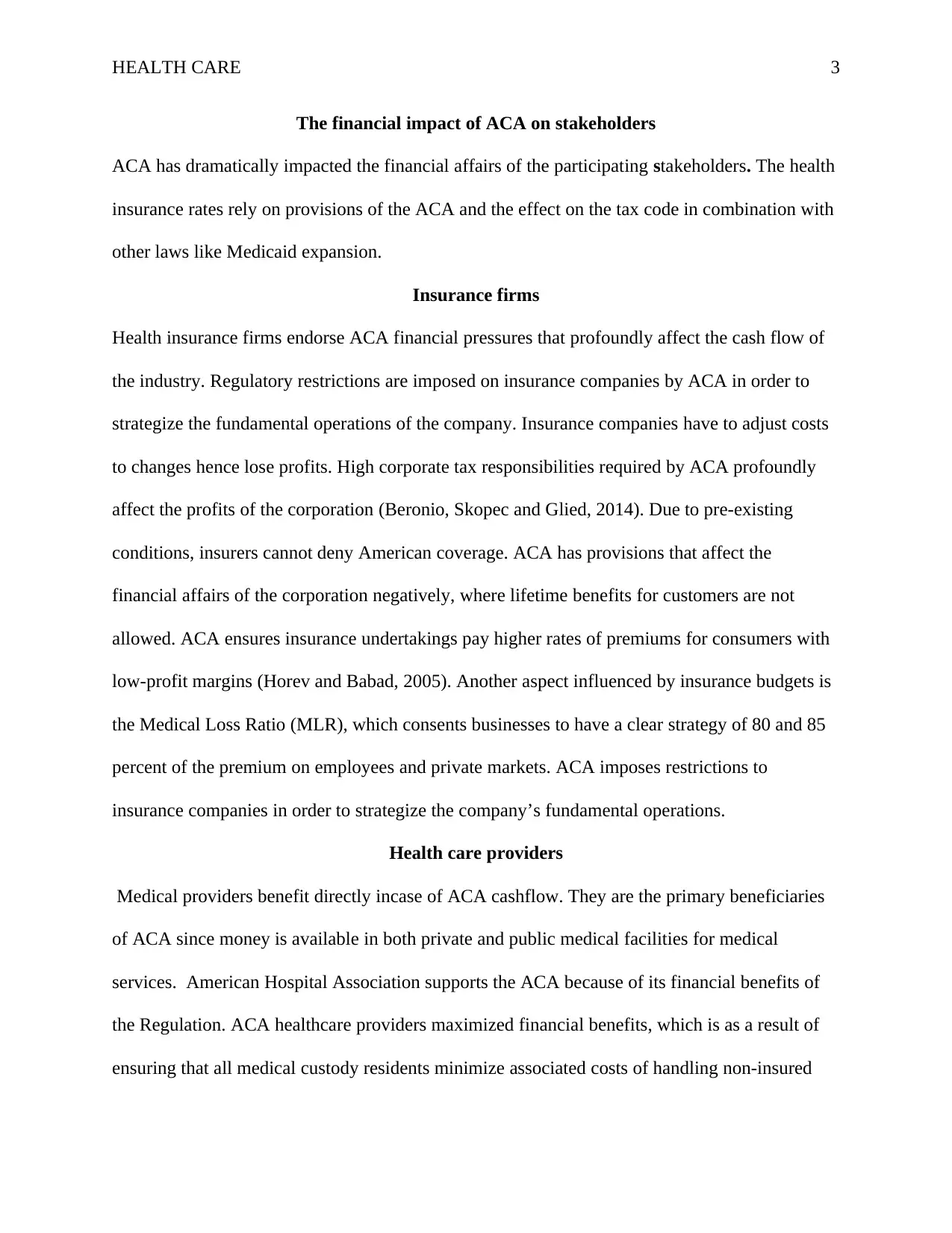
HEALTH CARE 3
The financial impact of ACA on stakeholders
ACA has dramatically impacted the financial affairs of the participating stakeholders. The health
insurance rates rely on provisions of the ACA and the effect on the tax code in combination with
other laws like Medicaid expansion.
Insurance firms
Health insurance firms endorse ACA financial pressures that profoundly affect the cash flow of
the industry. Regulatory restrictions are imposed on insurance companies by ACA in order to
strategize the fundamental operations of the company. Insurance companies have to adjust costs
to changes hence lose profits. High corporate tax responsibilities required by ACA profoundly
affect the profits of the corporation (Beronio, Skopec and Glied, 2014). Due to pre-existing
conditions, insurers cannot deny American coverage. ACA has provisions that affect the
financial affairs of the corporation negatively, where lifetime benefits for customers are not
allowed. ACA ensures insurance undertakings pay higher rates of premiums for consumers with
low-profit margins (Horev and Babad, 2005). Another aspect influenced by insurance budgets is
the Medical Loss Ratio (MLR), which consents businesses to have a clear strategy of 80 and 85
percent of the premium on employees and private markets. ACA imposes restrictions to
insurance companies in order to strategize the company’s fundamental operations.
Health care providers
Medical providers benefit directly incase of ACA cashflow. They are the primary beneficiaries
of ACA since money is available in both private and public medical facilities for medical
services. American Hospital Association supports the ACA because of its financial benefits of
the Regulation. ACA healthcare providers maximized financial benefits, which is as a result of
ensuring that all medical custody residents minimize associated costs of handling non-insured
The financial impact of ACA on stakeholders
ACA has dramatically impacted the financial affairs of the participating stakeholders. The health
insurance rates rely on provisions of the ACA and the effect on the tax code in combination with
other laws like Medicaid expansion.
Insurance firms
Health insurance firms endorse ACA financial pressures that profoundly affect the cash flow of
the industry. Regulatory restrictions are imposed on insurance companies by ACA in order to
strategize the fundamental operations of the company. Insurance companies have to adjust costs
to changes hence lose profits. High corporate tax responsibilities required by ACA profoundly
affect the profits of the corporation (Beronio, Skopec and Glied, 2014). Due to pre-existing
conditions, insurers cannot deny American coverage. ACA has provisions that affect the
financial affairs of the corporation negatively, where lifetime benefits for customers are not
allowed. ACA ensures insurance undertakings pay higher rates of premiums for consumers with
low-profit margins (Horev and Babad, 2005). Another aspect influenced by insurance budgets is
the Medical Loss Ratio (MLR), which consents businesses to have a clear strategy of 80 and 85
percent of the premium on employees and private markets. ACA imposes restrictions to
insurance companies in order to strategize the company’s fundamental operations.
Health care providers
Medical providers benefit directly incase of ACA cashflow. They are the primary beneficiaries
of ACA since money is available in both private and public medical facilities for medical
services. American Hospital Association supports the ACA because of its financial benefits of
the Regulation. ACA healthcare providers maximized financial benefits, which is as a result of
ensuring that all medical custody residents minimize associated costs of handling non-insured
⊘ This is a preview!⊘
Do you want full access?
Subscribe today to unlock all pages.

Trusted by 1+ million students worldwide
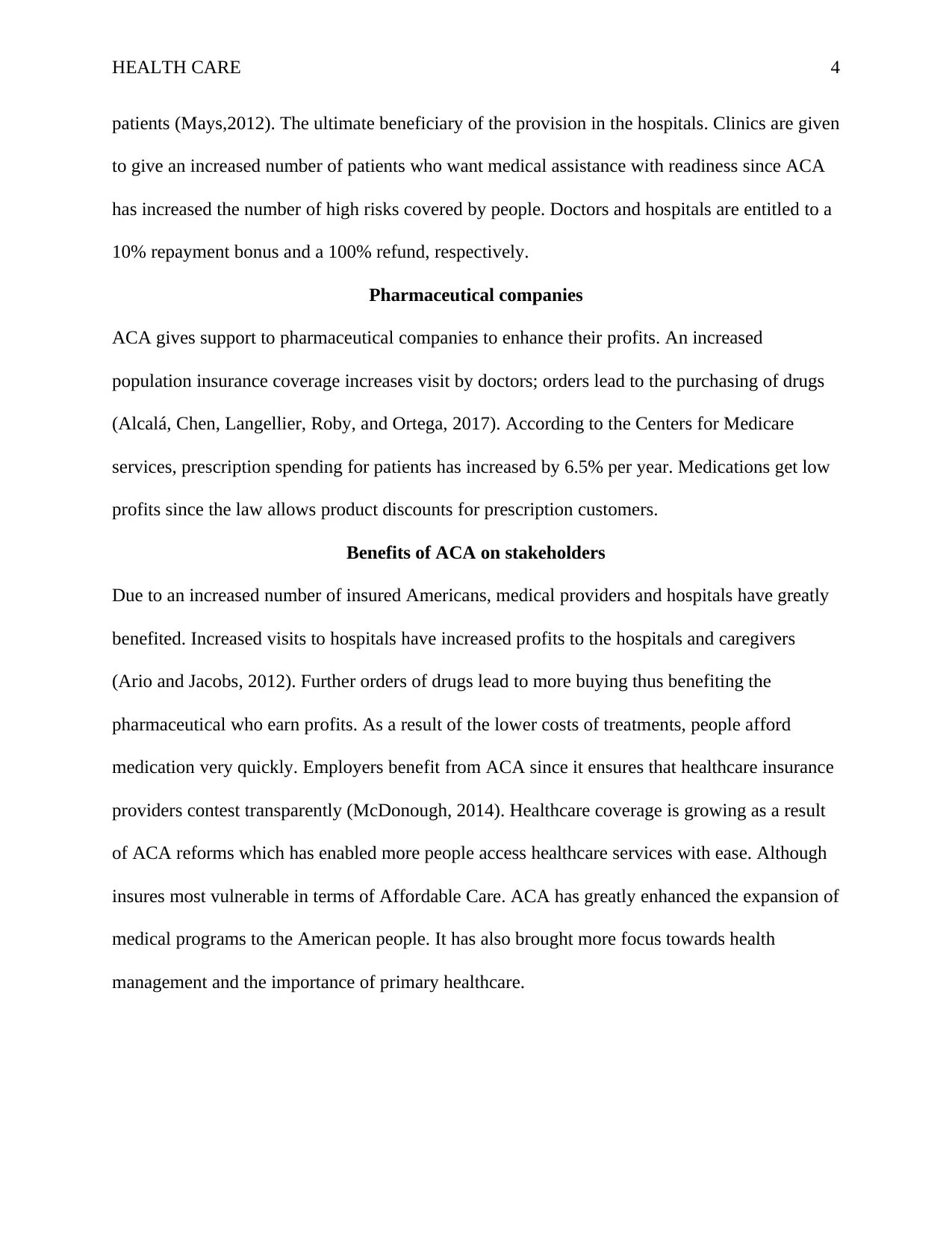
HEALTH CARE 4
patients (Mays,2012). The ultimate beneficiary of the provision in the hospitals. Clinics are given
to give an increased number of patients who want medical assistance with readiness since ACA
has increased the number of high risks covered by people. Doctors and hospitals are entitled to a
10% repayment bonus and a 100% refund, respectively.
Pharmaceutical companies
ACA gives support to pharmaceutical companies to enhance their profits. An increased
population insurance coverage increases visit by doctors; orders lead to the purchasing of drugs
(Alcalá, Chen, Langellier, Roby, and Ortega, 2017). According to the Centers for Medicare
services, prescription spending for patients has increased by 6.5% per year. Medications get low
profits since the law allows product discounts for prescription customers.
Benefits of ACA on stakeholders
Due to an increased number of insured Americans, medical providers and hospitals have greatly
benefited. Increased visits to hospitals have increased profits to the hospitals and caregivers
(Ario and Jacobs, 2012). Further orders of drugs lead to more buying thus benefiting the
pharmaceutical who earn profits. As a result of the lower costs of treatments, people afford
medication very quickly. Employers benefit from ACA since it ensures that healthcare insurance
providers contest transparently (McDonough, 2014). Healthcare coverage is growing as a result
of ACA reforms which has enabled more people access healthcare services with ease. Although
insures most vulnerable in terms of Affordable Care. ACA has greatly enhanced the expansion of
medical programs to the American people. It has also brought more focus towards health
management and the importance of primary healthcare.
patients (Mays,2012). The ultimate beneficiary of the provision in the hospitals. Clinics are given
to give an increased number of patients who want medical assistance with readiness since ACA
has increased the number of high risks covered by people. Doctors and hospitals are entitled to a
10% repayment bonus and a 100% refund, respectively.
Pharmaceutical companies
ACA gives support to pharmaceutical companies to enhance their profits. An increased
population insurance coverage increases visit by doctors; orders lead to the purchasing of drugs
(Alcalá, Chen, Langellier, Roby, and Ortega, 2017). According to the Centers for Medicare
services, prescription spending for patients has increased by 6.5% per year. Medications get low
profits since the law allows product discounts for prescription customers.
Benefits of ACA on stakeholders
Due to an increased number of insured Americans, medical providers and hospitals have greatly
benefited. Increased visits to hospitals have increased profits to the hospitals and caregivers
(Ario and Jacobs, 2012). Further orders of drugs lead to more buying thus benefiting the
pharmaceutical who earn profits. As a result of the lower costs of treatments, people afford
medication very quickly. Employers benefit from ACA since it ensures that healthcare insurance
providers contest transparently (McDonough, 2014). Healthcare coverage is growing as a result
of ACA reforms which has enabled more people access healthcare services with ease. Although
insures most vulnerable in terms of Affordable Care. ACA has greatly enhanced the expansion of
medical programs to the American people. It has also brought more focus towards health
management and the importance of primary healthcare.
Paraphrase This Document
Need a fresh take? Get an instant paraphrase of this document with our AI Paraphraser
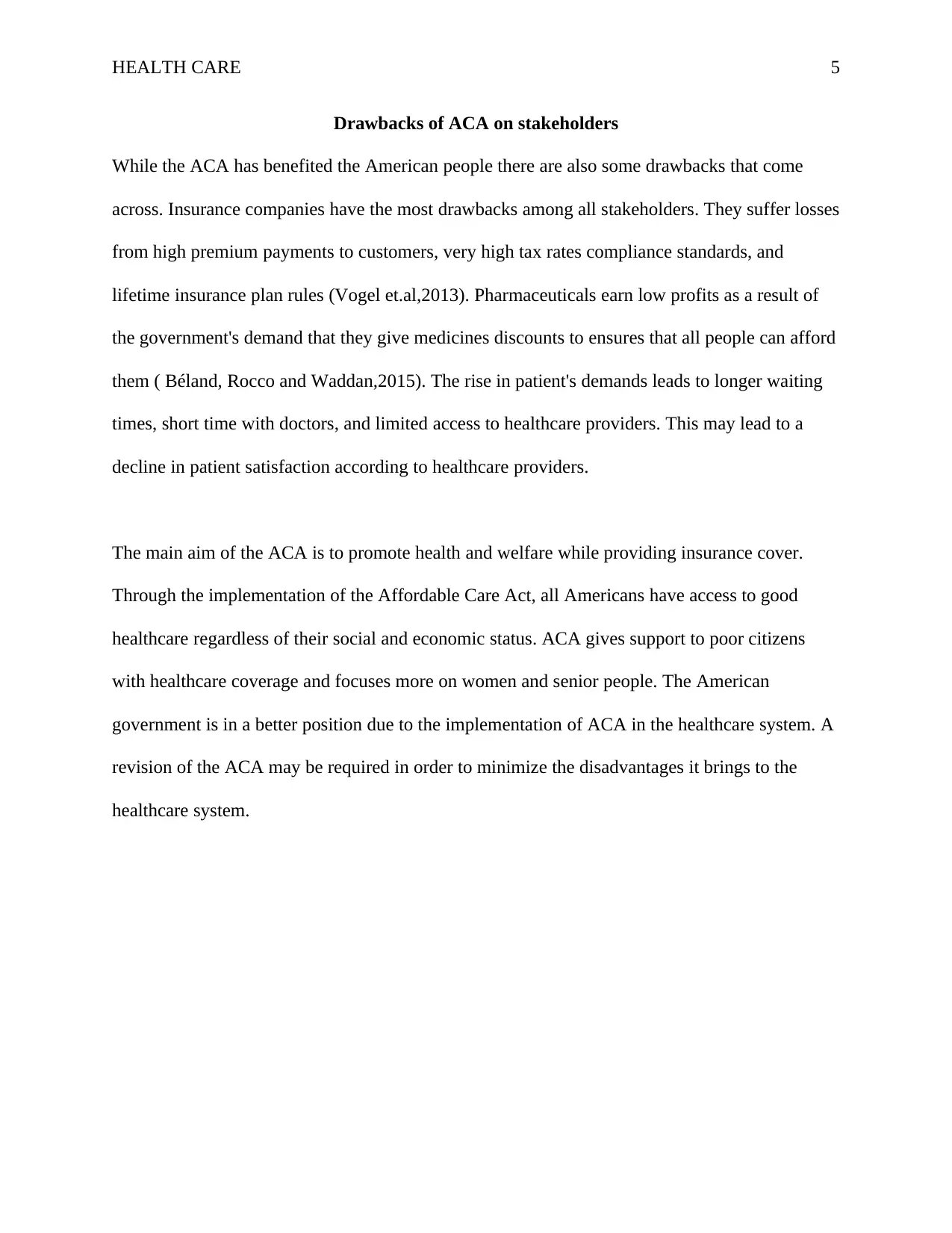
HEALTH CARE 5
Drawbacks of ACA on stakeholders
While the ACA has benefited the American people there are also some drawbacks that come
across. Insurance companies have the most drawbacks among all stakeholders. They suffer losses
from high premium payments to customers, very high tax rates compliance standards, and
lifetime insurance plan rules (Vogel et.al,2013). Pharmaceuticals earn low profits as a result of
the government's demand that they give medicines discounts to ensures that all people can afford
them ( Béland, Rocco and Waddan,2015). The rise in patient's demands leads to longer waiting
times, short time with doctors, and limited access to healthcare providers. This may lead to a
decline in patient satisfaction according to healthcare providers.
The main aim of the ACA is to promote health and welfare while providing insurance cover.
Through the implementation of the Affordable Care Act, all Americans have access to good
healthcare regardless of their social and economic status. ACA gives support to poor citizens
with healthcare coverage and focuses more on women and senior people. The American
government is in a better position due to the implementation of ACA in the healthcare system. A
revision of the ACA may be required in order to minimize the disadvantages it brings to the
healthcare system.
Drawbacks of ACA on stakeholders
While the ACA has benefited the American people there are also some drawbacks that come
across. Insurance companies have the most drawbacks among all stakeholders. They suffer losses
from high premium payments to customers, very high tax rates compliance standards, and
lifetime insurance plan rules (Vogel et.al,2013). Pharmaceuticals earn low profits as a result of
the government's demand that they give medicines discounts to ensures that all people can afford
them ( Béland, Rocco and Waddan,2015). The rise in patient's demands leads to longer waiting
times, short time with doctors, and limited access to healthcare providers. This may lead to a
decline in patient satisfaction according to healthcare providers.
The main aim of the ACA is to promote health and welfare while providing insurance cover.
Through the implementation of the Affordable Care Act, all Americans have access to good
healthcare regardless of their social and economic status. ACA gives support to poor citizens
with healthcare coverage and focuses more on women and senior people. The American
government is in a better position due to the implementation of ACA in the healthcare system. A
revision of the ACA may be required in order to minimize the disadvantages it brings to the
healthcare system.
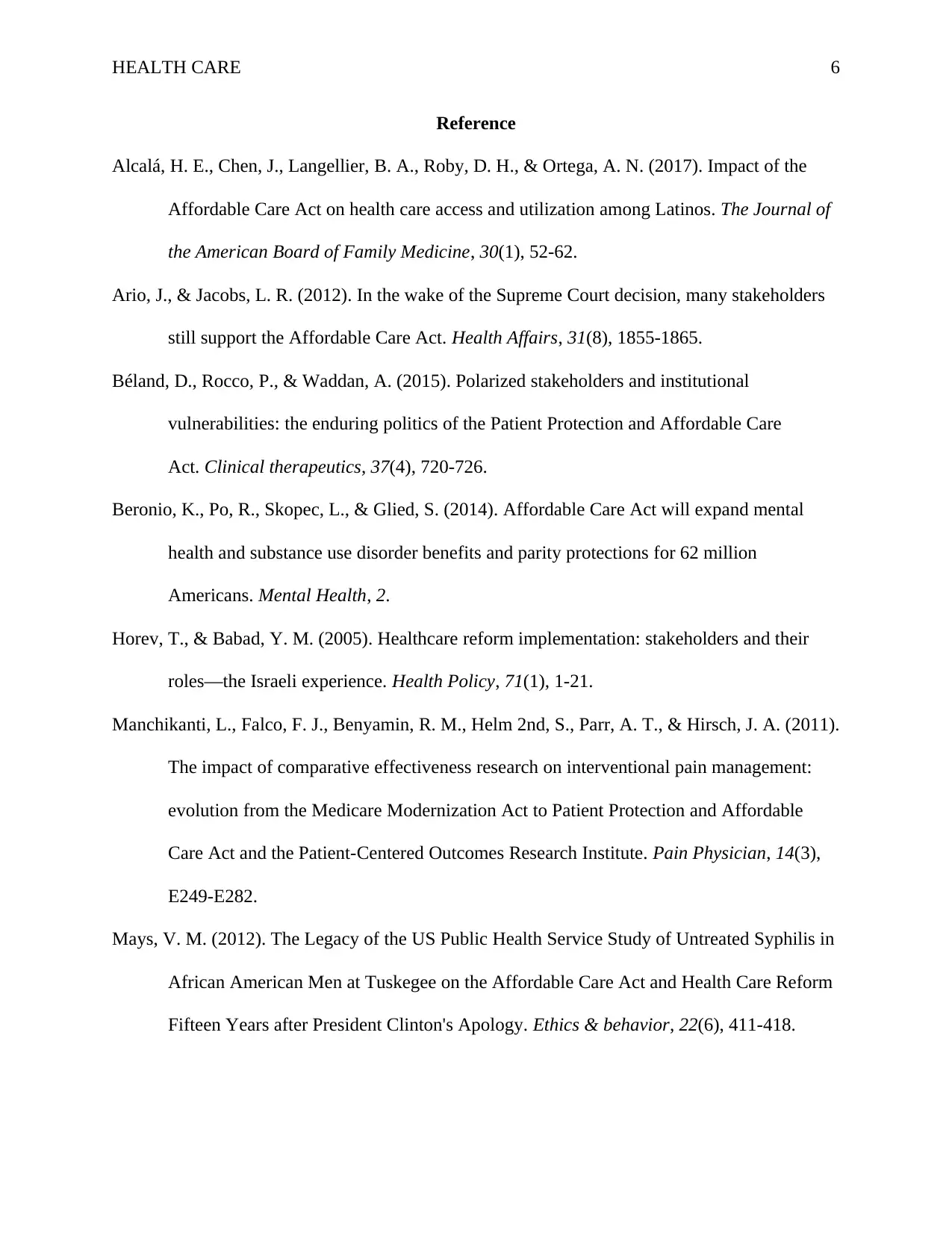
HEALTH CARE 6
Reference
Alcalá, H. E., Chen, J., Langellier, B. A., Roby, D. H., & Ortega, A. N. (2017). Impact of the
Affordable Care Act on health care access and utilization among Latinos. The Journal of
the American Board of Family Medicine, 30(1), 52-62.
Ario, J., & Jacobs, L. R. (2012). In the wake of the Supreme Court decision, many stakeholders
still support the Affordable Care Act. Health Affairs, 31(8), 1855-1865.
Béland, D., Rocco, P., & Waddan, A. (2015). Polarized stakeholders and institutional
vulnerabilities: the enduring politics of the Patient Protection and Affordable Care
Act. Clinical therapeutics, 37(4), 720-726.
Beronio, K., Po, R., Skopec, L., & Glied, S. (2014). Affordable Care Act will expand mental
health and substance use disorder benefits and parity protections for 62 million
Americans. Mental Health, 2.
Horev, T., & Babad, Y. M. (2005). Healthcare reform implementation: stakeholders and their
roles—the Israeli experience. Health Policy, 71(1), 1-21.
Manchikanti, L., Falco, F. J., Benyamin, R. M., Helm 2nd, S., Parr, A. T., & Hirsch, J. A. (2011).
The impact of comparative effectiveness research on interventional pain management:
evolution from the Medicare Modernization Act to Patient Protection and Affordable
Care Act and the Patient-Centered Outcomes Research Institute. Pain Physician, 14(3),
E249-E282.
Mays, V. M. (2012). The Legacy of the US Public Health Service Study of Untreated Syphilis in
African American Men at Tuskegee on the Affordable Care Act and Health Care Reform
Fifteen Years after President Clinton's Apology. Ethics & behavior, 22(6), 411-418.
Reference
Alcalá, H. E., Chen, J., Langellier, B. A., Roby, D. H., & Ortega, A. N. (2017). Impact of the
Affordable Care Act on health care access and utilization among Latinos. The Journal of
the American Board of Family Medicine, 30(1), 52-62.
Ario, J., & Jacobs, L. R. (2012). In the wake of the Supreme Court decision, many stakeholders
still support the Affordable Care Act. Health Affairs, 31(8), 1855-1865.
Béland, D., Rocco, P., & Waddan, A. (2015). Polarized stakeholders and institutional
vulnerabilities: the enduring politics of the Patient Protection and Affordable Care
Act. Clinical therapeutics, 37(4), 720-726.
Beronio, K., Po, R., Skopec, L., & Glied, S. (2014). Affordable Care Act will expand mental
health and substance use disorder benefits and parity protections for 62 million
Americans. Mental Health, 2.
Horev, T., & Babad, Y. M. (2005). Healthcare reform implementation: stakeholders and their
roles—the Israeli experience. Health Policy, 71(1), 1-21.
Manchikanti, L., Falco, F. J., Benyamin, R. M., Helm 2nd, S., Parr, A. T., & Hirsch, J. A. (2011).
The impact of comparative effectiveness research on interventional pain management:
evolution from the Medicare Modernization Act to Patient Protection and Affordable
Care Act and the Patient-Centered Outcomes Research Institute. Pain Physician, 14(3),
E249-E282.
Mays, V. M. (2012). The Legacy of the US Public Health Service Study of Untreated Syphilis in
African American Men at Tuskegee on the Affordable Care Act and Health Care Reform
Fifteen Years after President Clinton's Apology. Ethics & behavior, 22(6), 411-418.
⊘ This is a preview!⊘
Do you want full access?
Subscribe today to unlock all pages.

Trusted by 1+ million students worldwide
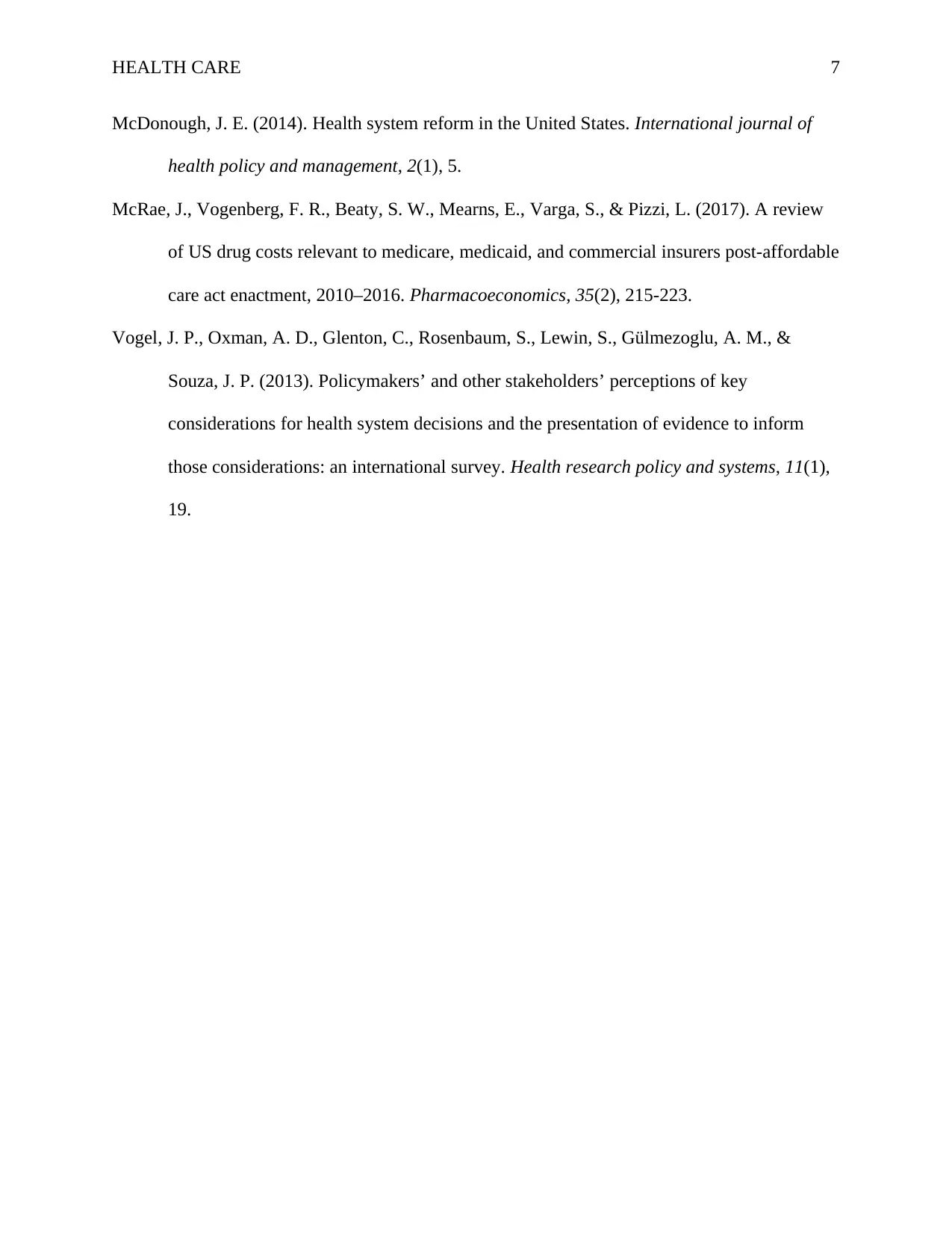
HEALTH CARE 7
McDonough, J. E. (2014). Health system reform in the United States. International journal of
health policy and management, 2(1), 5.
McRae, J., Vogenberg, F. R., Beaty, S. W., Mearns, E., Varga, S., & Pizzi, L. (2017). A review
of US drug costs relevant to medicare, medicaid, and commercial insurers post-affordable
care act enactment, 2010–2016. Pharmacoeconomics, 35(2), 215-223.
Vogel, J. P., Oxman, A. D., Glenton, C., Rosenbaum, S., Lewin, S., Gülmezoglu, A. M., &
Souza, J. P. (2013). Policymakers’ and other stakeholders’ perceptions of key
considerations for health system decisions and the presentation of evidence to inform
those considerations: an international survey. Health research policy and systems, 11(1),
19.
McDonough, J. E. (2014). Health system reform in the United States. International journal of
health policy and management, 2(1), 5.
McRae, J., Vogenberg, F. R., Beaty, S. W., Mearns, E., Varga, S., & Pizzi, L. (2017). A review
of US drug costs relevant to medicare, medicaid, and commercial insurers post-affordable
care act enactment, 2010–2016. Pharmacoeconomics, 35(2), 215-223.
Vogel, J. P., Oxman, A. D., Glenton, C., Rosenbaum, S., Lewin, S., Gülmezoglu, A. M., &
Souza, J. P. (2013). Policymakers’ and other stakeholders’ perceptions of key
considerations for health system decisions and the presentation of evidence to inform
those considerations: an international survey. Health research policy and systems, 11(1),
19.
1 out of 7
Related Documents
Your All-in-One AI-Powered Toolkit for Academic Success.
+13062052269
info@desklib.com
Available 24*7 on WhatsApp / Email
![[object Object]](/_next/static/media/star-bottom.7253800d.svg)
Unlock your academic potential
Copyright © 2020–2025 A2Z Services. All Rights Reserved. Developed and managed by ZUCOL.





